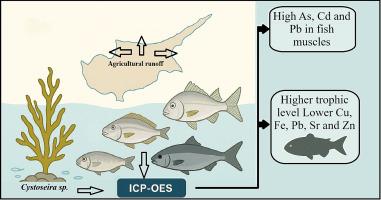Assessment of heavy metal contamination in Cystoseira sp. and ecologically distinct fish species from Northern Cyprus
IF 4.9
3区 环境科学与生态学
Q1 ENVIRONMENTAL SCIENCES
引用次数: 0
Abstract
In this study, Cystoseira sp. samples were collected by snorkeling during summer and winter from five coastal sites within the territorial waters of Northern Cyprus. In addition, herbivorous and carnivorous fish species inhabiting demersal, rocky-sandy, and epipelagic zones were obtained from local fishers across four representative regions. Concentrations of Ag, Al, As, Cd, Cr, Cu, Fe, Pb, Se, Sr, V, and Zn were measured in Cystoseira sp., and in fish liver and muscle tissues using inductively coupled plasma optical emission spectrometry (ICP-OES). Results were compared with previous studies conducted in Cyprus and neighboring Eastern Mediterranean countries. A significant negative correlation was observed between fish trophic levels and concentrations of Cu, Fe, Pb, Sr, and Zn. Metal concentrations were further evaluated against national and international food safety and environmental standards. Notably, some fish muscle samples contained As, Cd, and Pb above permissible limits, suggesting potential risks to human health. To further assess this issue, a human health risk evaluation (non-carcinogenic and carcinogenic) was performed under a realistic exposure scenario of two meals per week. All Hazard Index (HI) values were below 1, demonstrating no non-carcinogenic risk for either adults or children. Carcinogenic risk (CR) values were generally insignificant (<10−6), although As and Cd in some species reached the tolerable range (10−6–10−4) for children, while only As posed tolerable risk levels in adults. Furthermore, elevated As levels in marine organisms may be associated with agricultural runoff, emphasizing the need for tighter monitoring of agricultural practices in coastal areas.

北塞浦路斯Cystoseira sp.和生态独特鱼类中重金属污染的评估。
在这项研究中,在夏季和冬季,通过浮潜从北塞浦路斯领海内的五个沿海地点收集了Cystoseira sp.样本。此外,从四个代表性地区的当地渔民那里获得了生活在海底、岩砂和上层海洋的草食性和肉食性鱼类。采用电感耦合等离子体发射光谱法(ICP-OES)测定了银、铝、砷、镉、铬、铜、铁、铅、硒、锶、钒和锌在囊藻(Cystoseira sp.)以及鱼肝脏和肌肉组织中的浓度。研究结果与之前在塞浦路斯和邻近的东地中海国家进行的研究进行了比较。鱼类营养水平与Cu、Fe、Pb、Sr、Zn浓度呈显著负相关。根据国家和国际食品安全和环境标准进一步评价了金属浓度。值得注意的是,一些鱼类肌肉样本中砷、镉和铅的含量超过了允许的限度,表明对人体健康存在潜在风险。为了进一步评估这一问题,在每周两餐的现实接触情景下进行了人类健康风险评估(非致癌性和致癌性)。所有的危害指数(HI)值都低于1,表明对成人和儿童都没有非致癌风险。致癌风险(CR)值一般不显著(-6),尽管某些物种的砷和镉达到儿童可耐受范围(10-6-10-4),而成人只有砷具有可耐受的风险水平。此外,海洋生物中砷含量的升高可能与农业径流有关,这强调需要更严格地监测沿海地区的农业做法。
本文章由计算机程序翻译,如有差异,请以英文原文为准。
求助全文
约1分钟内获得全文
求助全文
来源期刊

Marine pollution bulletin
环境科学-海洋与淡水生物学
CiteScore
10.20
自引率
15.50%
发文量
1077
审稿时长
68 days
期刊介绍:
Marine Pollution Bulletin is concerned with the rational use of maritime and marine resources in estuaries, the seas and oceans, as well as with documenting marine pollution and introducing new forms of measurement and analysis. A wide range of topics are discussed as news, comment, reviews and research reports, not only on effluent disposal and pollution control, but also on the management, economic aspects and protection of the marine environment in general.
 求助内容:
求助内容: 应助结果提醒方式:
应助结果提醒方式:


